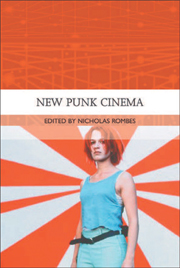Book contents
- Frontmatter
- Contents
- Notes on the Contributors
- Acknowledgements
- Introduction
- PART I BACKGROUNDS AND CONTEXTS
- PART II SCREENING NEW PUNK CINEMA
- PART III CASE STUDIES
- 10 Dogma Brothers: Lars von Trier and Thomas Vinterberg
- 11 Mike Figgis: Time Code and the Screen
- 12 What Was the Neo-Underground and What Wasn't: A First Reconsideration of Harmony Korine
- 13 Repo Man: Reclaiming the Spirit of Punk with Alex Cox
- Bibliography
- Index
10 - Dogma Brothers: Lars von Trier and Thomas Vinterberg
from PART III - CASE STUDIES
Published online by Cambridge University Press: 05 August 2013
- Frontmatter
- Contents
- Notes on the Contributors
- Acknowledgements
- Introduction
- PART I BACKGROUNDS AND CONTEXTS
- PART II SCREENING NEW PUNK CINEMA
- PART III CASE STUDIES
- 10 Dogma Brothers: Lars von Trier and Thomas Vinterberg
- 11 Mike Figgis: Time Code and the Screen
- 12 What Was the Neo-Underground and What Wasn't: A First Reconsideration of Harmony Korine
- 13 Repo Man: Reclaiming the Spirit of Punk with Alex Cox
- Bibliography
- Index
Summary
When Thomas Vinterberg's The Celebration, the first film to be made under the aegis of the Danish film movement Dogma 95, premièred at the 1998 Cannes Film Festival, audiences were astounded that what looked like a home movie had ‘somehow wandered onto the screen’ (Kelly 2000a). This was due not only to its story of incest and a dysfunctional family but also to its assaultive style, characterised by unsteady camera-work and shock-cuts – a result of following the ten film-making rules in the Dogma 95 Manifesto, designed to counter ‘“certain tendencies” in the cinema today’ (Kelly 2000b: 226).
Known as the ‘Vow of Chastity’, the Dogma rules stipulate location-shooting (no imported sets or props are allowed), direct sound (produced at the time of filming and not dubbed over the images afterwards), hand-held camera (always following the actors, rather than forcing actors to move to where the camera is standing), colour film stock and available lighting (rather than special film lighting) and Academy 35 mm format. They also forbid optical work and filters, superficial action (that is, murders and weapons ‘must not occur’), genre movies, ‘temporal and geographical alienation’ (films must be set ‘here and now’), and state that ‘the director must not be credited’ (Kelly 2000b: 227–8).
- Type
- Chapter
- Information
- New Punk Cinema , pp. 153 - 167Publisher: Edinburgh University PressPrint publication year: 2005



